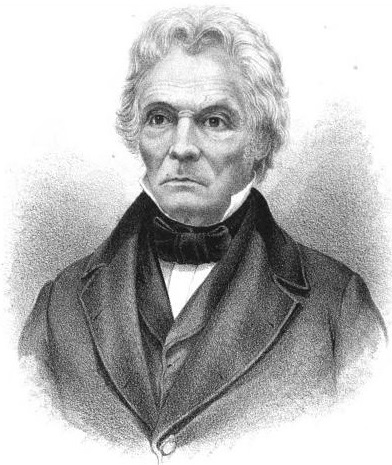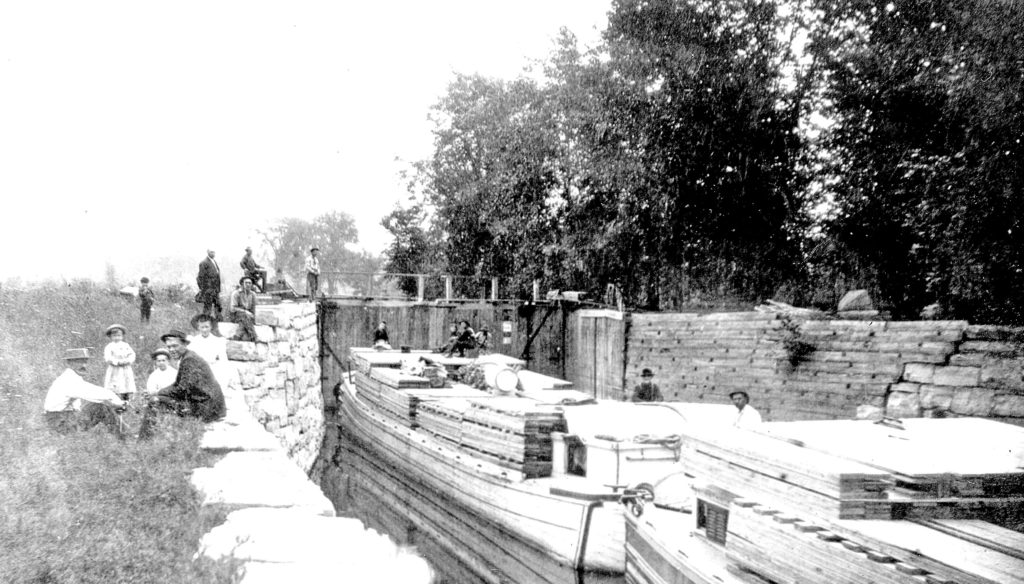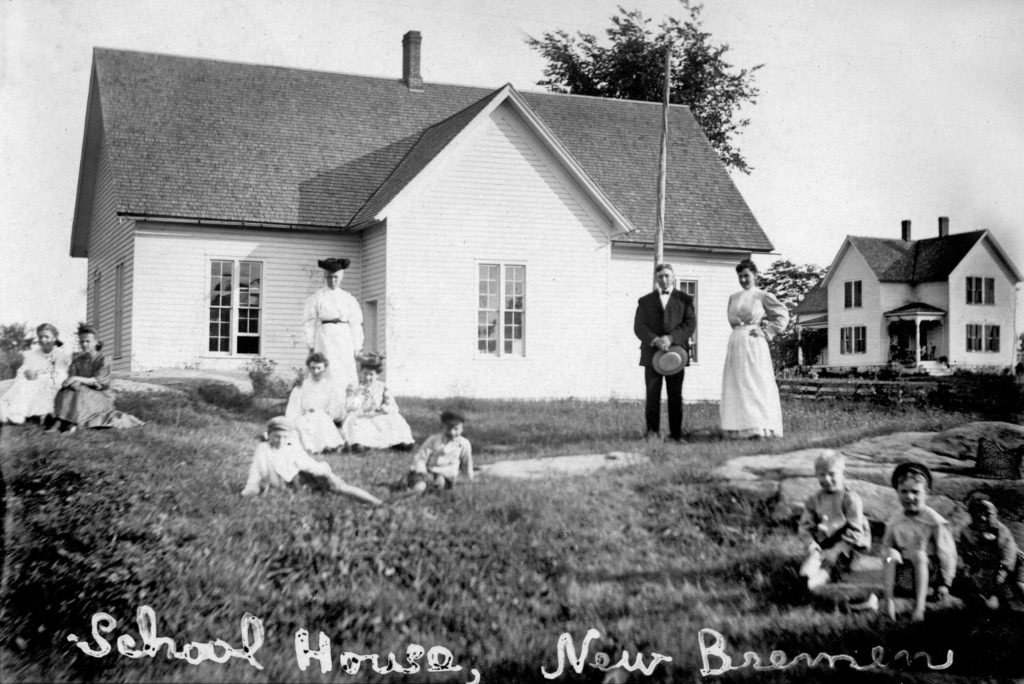On March 31, 1848, the New York State legislature created the town of New Bremen from the towns of Croghan and Watson – its history, however, began a half-century earlier when the French attempted to build a settlement on the Beaver River. The “La Compagnie de New York” bought a 630,000 acre tract of land from William Constable, Sr., with plans to create the new city of Castorville modeled on Paris, France.
About 1794, the first French settlers headed down Black River from what at the time was known as High Falls (today, Lyons Falls) to the confluence of the Black and the Beaver Rivers. They subsequently traveled some 4 miles up the Beaver River to the falls and the site that the surveyors had chosen for their new French city – and there they began to build cabins and clear land in the wilderness. As the new site was at the same approximate latitude as Paris, the pioneers expected the climate to be about the same. They soon discovered, however, how harsh winter weather could be and after a few short, unsuccessful years, they largely abandoned the new city, moving to regions that were more hospitable. In the ensuing years, the forest reclaimed the clearings and the structures decayed until no trace of the planned city remained.
Following the failure of the Castorland company, Frenchman James Le Ray de Chaumont (and his son, Vincent) subsequently acquired much of the land, but little was done to market plots for settlement in the area embodied by New Bremen until about 1821 when Charles Dayan, from Lowville, was hired as their local land agent. Dayan had much of the land surveyed into plots, which he in turn sold to European immigrants. A settlement was established on Crystal Creek about a mile from Illingworth’s place on Black River. It was named Dayanville by Le Ray to compliment the land agent, and a dam was built on the creek and various factories were soon established.

Before Dayan’s involvement, however, Jacob Guba Cedar had been appointed resident agent but almost immediately turned his holdings and responsibilities over to Samuel Illingworth and left for parts unknown. Illingworth lived on the Black River, at the preferred river crossing from Lowville for sportsmen and others heading into the forest in the east, and for many years, Illingworth was the only inhabitant of the area. He died in 1847 at age 86.
Charles Dayan’s efforts attracted several settlers to what is now the town of New Bremen. In 1826, a dam and sawmill were built on Crystal Creek and Dayanville began growing. Land was cleared for farming and a rake factory was built in 1840, followed by a grist mill, cheese factory, blacksmith shops and several other businesses. About 1853 the route of the Saratoga and Sackett’s Harbor railroad was to pass close to the settlement and work was underway on grading the roadbed. In anticipation of the coming railroad, a 40 x 100 foot machine shop was built on Crystal Creek in Dayanville. However, the railroad failed to materialize and a few years later the building was enlarged and turned into a tannery.

When the town was officially created in 1848, the name of the little village was changed to New Bremen after the postal department changed the name of the post office. The hamlet is situated on the main route to the east and in 1906 a railroad finally came along when the Lowville and Beaver River Railroad was built to Croghan. The depot was at the Artz Road crossing, with siding to the Borden milk plant.
On the north side of the town, it would be a number of years after the failure of the Castorland project before further attempts at settlement were made, when the Rohr brothers set up a sawmill on the Croghan side of the Beaver River. As more settlers moved to Rohr’s Mills (later Beaver Falls), other timber-related businesses sprang up, including sawmills, tanneries, and pulp and paper mills. Products were shipped on canal boats that were towed down the Black River by steam tug, then up the Beaver River to Beaver Falls by horses or mules. But the waterways could only operate in the warm seasons. And so it was decided to build a railroad that would offer fast, reliable, year-round transportation for passengers and freight.

The Black River forms the town’s western boundary and from 1855 to about 1910 was a busy commercial waterway. The community of Van Amber’s Mills grew around Watson and Henry Van Amber’s steam powered sawmill and boat works on the Black River. The community of Van Amber’s Mills included several homes, a store, a farm and a one-room school. The sawmill burned in 1883; it was rebuilt in 1900; but it was again destroyed by fire caused by sparks from a passing T.B. Basselin steamer. The Van Amber brothers decided not to rebuild and sold their boats to Basselin and the community gradually disappeared. In its heyday, however, millions of board feet of lumber were sawn and several canal boats constructed at Van Amber’s Mills.
George Kirschner, who came from Alsace-Lorraine and migrated to the Croghan area with his family about 1842, founded the hamlet of Kirschnerville. He bought land east of French Settlement (i.e., Croghan) on the banks of Murmur Creek where he built a log home and a cobbler shop and was soon joined by others from Europe. Fairly quickly, Kirschnerville had a schoolhouse, a hotel, a sawmill, a cheese factory, and the carpet weaver. Several dwellings still stand, and the Mennonite Heritage Farm is a short distance north. The farm was one of the first built by Mennonite settlers who came to America to escape religious persecution in their native Germany. The farm has been restored as a museum to preserve the history of the early Mennonites.
Crystal Dale, in eastern New Bremen was a typical four-corners small community with a sawmill, a cheese factory, a schoolhouse and a post office. The industries have long since disappeared and the schoolhouse was converted into a home, as was the store. The little hamlet stands at the intersection of the Number Four and Erie Canal Roads.

The only incorporated village is Croghan, which today sits astride the New Bremen – Croghan town line. Originally called French Settlement, it took the name Croghan after the Town of Croghan was created in 1840. The political dividing line passes just north of St. Stephen’s Church that is in the town of New Bremen. St. Stephen’s was once a thriving religious institution with a school, a convent for nuns and a monastery where members of the Franciscan order of Friars Minor received training. The spire of St. Stephen’s is the tallest structure in the area and can be seen from afar.
Other churches in the town of New Bremen were Baptist, Methodist, German Lutheran, Mennonite, and apostolic Christian. The New Bremen Methodist and German Lutheran churches have disappeared, but the others remain, although St. Peter’s in the hamlet of New Bremen is no longer active.
The original New Bremen town garage sits at the intersection of State Route 812 and the Mattis Road, but when the highway was rebuilt in 1969, a new, much larger garage was built at the Route 812 – Tillman Road intersection. In 1995, a municipal offices addition was built onto the north end to house the offices of the town clerk, assessor, justices and courtroom, as well as voting districts one and two.

Of the several mills that once relied on waterpower from Crystal Pond, only the grist mill remains. The New Bremen fire department built a new fire hall in 1994 on the site of the two-room schoolhouse that had been used as a community center until it was deemed unsafe and torn down. The largest employer in the town is the Beaver Falls Central School on the Artz Road near the hamlet of Beaver Falls.
